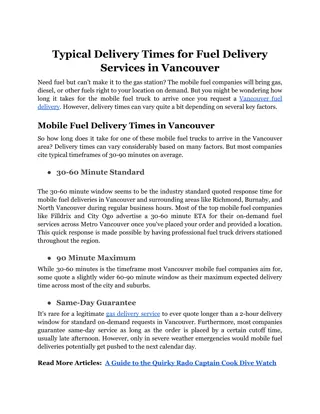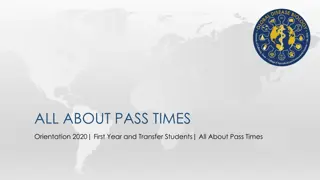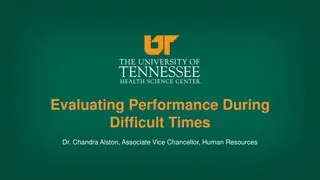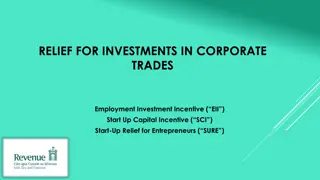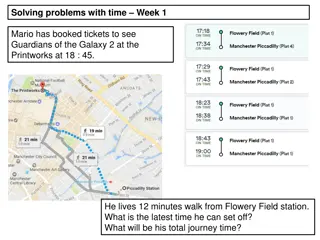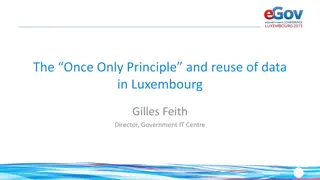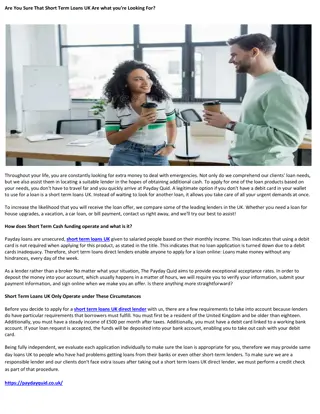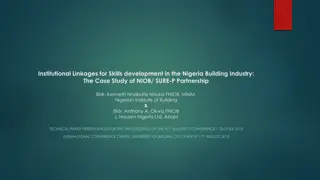"Once? No. Twenty times? Sure!"
This study explores how uncertainty and precommitment play a role in repeated decision-making, particularly when faced with rare events and low probability outcomes. It delves into how time horizons can influence subjective probabilities and the effectiveness of precommitment strategies in decision-making scenarios. Through various examples and research motivations, the research aims to shed light on the impact of uncertainty and the potential remedies through precommitment.
Download Presentation

Please find below an Image/Link to download the presentation.
The content on the website is provided AS IS for your information and personal use only. It may not be sold, licensed, or shared on other websites without obtaining consent from the author.If you encounter any issues during the download, it is possible that the publisher has removed the file from their server.
You are allowed to download the files provided on this website for personal or commercial use, subject to the condition that they are used lawfully. All files are the property of their respective owners.
The content on the website is provided AS IS for your information and personal use only. It may not be sold, licensed, or shared on other websites without obtaining consent from the author.
E N D
Presentation Transcript
"Once? No. Twenty times? Sure!" Uncertainty and precommitment in repeated choice David J. Hardisty, Amir Sepehri, Poonam Arora UBC Sauder , Western Ivey, Manhattan College Funding support from NSF and SSHRC UBC-UW Marketing Conference May, 2019
Background Currently in major revision Now two different papers! Today s version: with warts! no file drawer Suggestions and criticisms welcome
Decision Making with Rare Events Poor decision making with low probability events: Extreme weather events (e.g., earthquake, flood) Data backup Nighttime visibility
Research Motivation Normally, greater delay is associated with increased uncertainty example: $10 promised today or in 20 years However, with repeated low probability events, increasing time horizon may increase subjective probability Examples (choice bracketing): Chance of a fire today or over 20 years? Wear your seatbelt just once or every time? (Slovic, Fischhoff, & Lichtenstein, 1978)
Precommitment as a Remedy? People sometimes precommit to invest in protection for several years in advance at a time examples: Binding commitments: long-term insurance contracts Non-binding commitments: safety decisions (seat-belt, helmet, etc) Social dilemmas: CO2 reductions
Why Precommitment? Slovic, Fischhoff, & Lichtenstein, 1978 Choice Bracketing Precommitment Scale Design as Choice Architecture Tools Camilleri & Larrick, 2014 Description vs. Experience of the Risk Hertwig, Barron, Weber, & Erev, 2004 Kahneman & Tversky, 1979 Integrating losses Intertemporal Uncertainty Avoidance Hardisty & Pfeffer, 2017
Working Model Subjective probability (of large loss) + Time horizon + + + Preference for safer option Precommitment
Study 1 Question: Do individuals invest more in the safe option when they precommit their choices?
Instructions (pg 1) Imagine you are an investor in Indonesia and you have a risky venture that earns 8,500 Rp per year. However, there is a small chance that you will suffer a loss of 40,000 Rp in a given year. You have the option to pay 1,400 Rp for a safety measure each year to protect against the possible loss. You will be fully protected if you invest in protection. The loss has an equal chance of happening each year, regardless of whether it occurred in the previous year.
Choice - You definitely lose 1,400 Rp, and have a 0% chance of the large loss occurring. - You have a 4% chance of losing 40,000 Rp and a 96% chance of losing 0 Rp. INVEST NOT INVEST
Choices Repeated Condition: Will you invest in protection this year? INVEST | NOT INVEST Precommitted condition: Will you invest in protection in year 1? INVEST | NOT INVEST ~~~~~~~~~~~~~~~~~~~~~~~~~~~~~~~~~~~~~~~~~~~~~~~~~~~~~~~~~~~~~~~~~~~~~~ Will you invest in protection in year 2? INVEST | NOT INVEST ~~~~~~~~~~~~~~~~~~~~~~~~~~~~~~~~~~~~~~~~~~~~~~~~~~~~~~~~~~~~~~~~~~~~~~ [...] Will you invest in protection in year 20? INVEST | NOT INVEST
Feedback Year 1 Results Your choice: INVEST The random number was: 88 This Means The large loss: did not occur Result: You lost 1,400 Rp.
Feedback Year 2 Results Your choice: NOT INVEST The random number was: 3 This Means The large loss: occurred Result: You lost 40,000 Rp.
Design Details Comprehension test Participants (N=60 students) played 4 blocks of 20 rounds ( years ) 1 block paid out for real money Between subjects: repeated vs precommited choice
Solo: repeated vs precommited 1 0.9 Investment Proportion 0.8 0.7 0.6 0.5 Repeated Precommitted 0.4 0.3 0.2 0.1 0 Block 1 Block 2 Block 3 Block 4
Self-report Data Across studies, self-report: the likelihood that a loss would occur at least once in 20 rounds (___%) Risk perception (1-7 scale) Risk concern (1-7 scale) Time horizon (___ months) All null results!
Study 2 Question: How does a change in the actual probabilities of the large loss affect precommitment?
Study 2: Theory If precommitment works by increasing subjective probability, then explicit increases in probability (with EV constant) should have the same effect (and should wipe out the effect of precommitment)
Study 2 Modified Solo game, N=421 MTurkers Slightly modified version with mining in the Known region (certain loss of 1400 Rp) or the Unknown region (4% chance of a 40,000 Rp. loss) Repeated vs Precommitted Probability of the big loss (4% vs. 20% vs. 50%)
Study 2: Choice - You definitely lose 1,400 Rp, and have a 0% chance of the large loss occurring. - You have a 4% chance of losing 40,000 Rp and a 96% chance of losing 0 Rp. KNOWN UNKNOWN
Study 2: Choice - You definitely lose 1,400 Rp, and have a 0% chance of the large loss occurring. - You have a 20% chance of losing 8,000 Rp and a 80% chance of losing 0 Rp. KNOWN UNKNOWN
Study 2: Choice - You definitely lose 1,400 Rp, and have a 0% chance of the large loss occurring. - You have a 50% chance of losing 3,200 Rp and a 50% chance of losing 0 Rp. KNOWN UNKNOWN
Study 2: Results 0.8 Mean investment proportion 0.7 0.6 0.5 0.4 0.3 0.2 0.1 0 4% Repeated 20% Precommited 50%
Conclusion Precommitment effect becomes weaker and eventually non-significant as the probability of big loss increases. Why? Because when the probability is already high, there is little room for precommitment to increase the subjective likelihood of the big loss.
Study 3 Question: How does a change in the Decision- Making time horizon affect precommitment?
Study 3: Theory If precommitment increases time horizon, then experimentally increasing the time horizon should have the same effect and should wipe out the effect of precommitment Also, we should see the same result even when the risky result is EV maximizing
Study 3 N=567 MTurkers Repeated vs Precommitted Time horizon manipulation (vs no-instruction control): Think about all the 20 rounds of the game. What is the best strategy? How many rounds out of 20 you think you should invest? Expected Value Advantage (Risky vs. Safe) Known region: Fixed pay of 1400 Unknown region: 4% chance of paying 40,000 Rp. vs. 30,000 Rp.
Results: Safe Choice Advantage Risky Choice Advantage 0.6 0.6 Mean investment proportion in safe 0.5 0.5 0.4 0.4 0.3 0.3 option 0.2 0.2 0.1 0.1 0 0 Repeated Precommitted Repeated Precommitted DM time-horizon: Control DM time-horizon: Aggregate DM time-horizon: Control DM time-horizon: Aggregate
Study 3: Results 0.6 Mean investment proportion in 0.5 0.4 safe option 0.3 0.2 0.1 0 Repeated DM Time Horizon: Control DM Time Horizon: Aggregate Precommited
Conclusion Urging participants to think about all 20 rounds of the game: Increased the choice of safe option in the repeated condition. Did not have any effect in the precommitment condition. Further supports our increase in time- horizon account.
Study 4 Question: Is pre-commitment binding?
Study 4: Theory If precommitment increases time horizon, then non-binding precommitment should have the same effect
Study 4 N=210 MTurkers Repeated vs Precommitted vs. non- binding precommitted Key difference: Ability to change precommitted choices after each round
Study 4: Results 0.6 Mean investment proportion 0.5 0.4 0.3 0.2 0.1 0
Conclusion Non-binding precommitment is as effective as the binding precommitment. Further supports our process account.
Study 5 Question: How does precommitment affect investment rates in a gain frame?
Study 5: Theory If precommitment increases time horizon and subjective probability, then gains should show the opposite effect
Study 5 N=355 students (at UBC and Ivey!) Incentive compatible Repeated vs Precommitted Loss vs Gain (Also varied choice presentation format to be aggregated vs separated; this is null.)
Study 5: Loss Choice - You definitely pay 1,400 Rp, and have a 0% chance of the large loss occurring. - You have a 4% chance of paying 40,000 Rp and a 96% chance of paying 0 Rp. KNOWN UNKNOWN
Study 5: Gain Choice - You definitely receive 1,400 Rp, and have a 0% chance of the gain loss occurring. - You have a 4% chance of receiving 40,000 Rp and a 96% chance of receiving 0 Rp. KNOWN UNKNOWN
Study 5: Results 0.8 0.7 Mean investment 0.6 proportion 0.5 0.4 0.3 0.2 0.1 0 Loss Gain Repeated Precomitted
Study 5: Conclusion The effect of precommitment on the attractiveness of a big gain is eliminated and slightly reversed
Study 6: Methods IV: Number of rounds in each block: 20 vs 10 vs 5 Prediction: pre-commitment should be less effective with shorter blocks
Study 6: Results Repeated 0.6 Precommitted Mean investment proportion 0.5 0.4 0.3 0.2 0.1 0 20 10 5 Number of rounds
Study 7: Methods Probability education intervention: 4% chance of losing 40,000 (this means that there is a 56% chance of the 40,000 payment happening at least once during 20 months) Prediction: education should increase investment rates, and decrease the effect of precommitment
Study 7: Results 0.7 Mean investment proportion 0.6 0.5 0.4 0.3 0.2 0.1 0 Control Repeated Education Precommitted
Paper 1: Summary Precommitment increases investment in protective measures and selection of safer options. Some experimental support for this mechanism, but not self-report Next step: think-aloud protocol
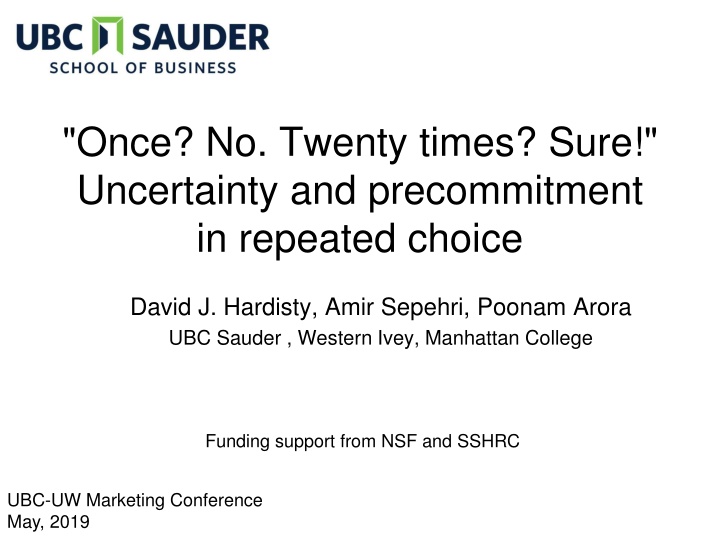

![❤Book⚡[PDF]✔ Fool Me Once: Should I Take Back My Cheating Husband?](/thumb/20473/book-pdf-fool-me-once-should-i-take-back-my-cheating-husband.jpg)

